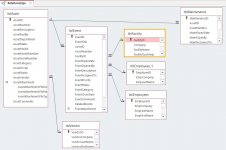An event would be tied to only one asset while an asset can have multiple events (over time). With that being said, I need to read up on relationships. I will reverse it.@Kyp,
I forgot to mention that your relationship between Event and Asset appears to be backwards unless I don't know what an asset is. If you can have more than one asset assigned to an Event, then you need a junction table between Event and Asset so you can assign multiple Assets to multiple events. You would remove AssitID from the Event table since that restricts you to a single asset for an event. Regardless, it is incorrect to have AssetNumber in Event. It should exist ONLY in the Asset table.
I only did this as to not confuse myself. Opening the DS I do see what you are saying. I will fix this.I would also not prefix all column names with table information. This just forces you to type more characters before useful intellisense kicks in and it hides the actual column name when you open the table in DS view or a query because all you see are the prefixes and maybe one or two characters of the actual column name.
I kind of understand what you're saying but I can't find where I used any duplication. Can you elaborate a little more on this please?For column names that occur in multiple tables such as the address fields, I wouldn't worry about the "duplication". If you have to use the two tables in the same query, you can alias the names from one table using a prefix to disambiguate the reference.
Once the db is split, the BE will be stored on the corp network in a shared drive accessible by everyone. In the same folder as the BE I want to store the attachments in a separate folder and as you stated, storing as a path rather than the image. This would dramatically increase the overall db size and will eventually exceed the 2GB limit. (I read this in a previous reply). My only issue is that I will have to learn how to accomplish this when the time comes.And finally, although there is nothing wrong with the Attachment data type per se, you need to be aware that it is not supported by SQL Server or other RDBMS' so if you ever have to upsize, you would need to not only convert the data manually, but also modify the app since you would need to handle OLE objects differently from Attachments. If you don't envision ever having to upgrade the BE, then the Attachment data type is fine although for images, I would still recommend storing the path rather than the object itself because Jet/ACE bloat easily when you embed objects. SQL Server is better equipped to handle OLE objects.

